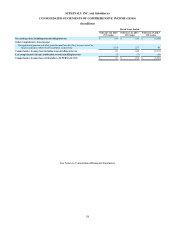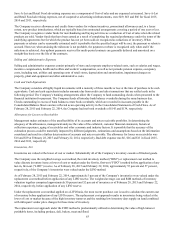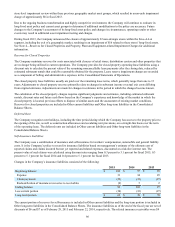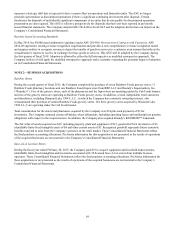Albertsons 2015 Annual Report Download - page 67
Download and view the complete annual report
Please find page 67 of the 2015 Albertsons annual report below. You can navigate through the pages in the report by either clicking on the pages listed below, or by using the keyword search tool below to find specific information within the annual report.65
expectations of the current and future operating environment. The rates used to discount projected future cash flows reflect a
weighted average cost of capital based on the Company’s industry, capital structure and risk premiums in each reporting unit,
including those reflected in the current market capitalization. If management identifies the potential for impairment of
goodwill, the implied fair value of the goodwill is calculated as the difference between the fair value of the reporting unit and
the fair value of the underlying assets and liabilities, excluding goodwill. An impairment charge is recorded for any excess of
the carrying value over the implied fair value.
The Company reviews the composition of its reporting units on an annual basis and on an interim basis if events or
circumstances indicate that the composition of the Company’s reporting units may have changed. There were no changes in the
Company’s reporting units as a result of the fiscal 2015 and 2014 reviews.
Intangible Assets, Net
The Company reviews intangible assets with indefinite useful lives, which primarily consist of trademarks and tradenames, for
impairment during the fourth quarter of each year, and also if events or changes in circumstances indicate that the asset might
be impaired. The reviews consist of comparing estimated fair value to the carrying value. Fair values of the Company’s
trademarks and tradenames are determined primarily by discounting an assumed royalty value applied to management’s
estimate of projected future revenues associated with the tradename using management’s expectations of the current and future
operating environment. The royalty cash flows are discounted using rates based on the weighted average cost of capital
discussed above and the specific risk profile of the tradenames relative to the Company’s other assets. These estimates are
impacted by variable factors, including inflation, the general health of the economy and market competition. The calculation of
the impairment charge contains significant judgments and estimates, including the weighted average cost of capital and the
specified risk profile of the tradename and future revenue and profitability.
Impairment of Long-Lived Assets
The Company monitors the recoverability of its long-lived assets such as buildings and equipment, and evaluates their carrying
value for impairment whenever events or changes in circumstances indicate that the carrying amount of such assets may not be
fully recoverable. Events that may trigger such an evaluation include current period losses combined with a history of losses or
a projection of continuing losses, a significant decrease in the market value of an asset or the Company’s plans for store
closures. When such events or changes in circumstances occur, a recoverability test is performed by comparing projected
undiscounted future cash flows to the carrying value of the group of assets being tested.
If impairment is identified for long-lived assets to be held and used, the fair value is compared to the carrying value of the
group of assets and an impairment charge is recorded for the excess of the carrying value over the fair value. For long-lived
assets that are classified as assets held for sale, the Company recognizes impairment charges for the excess of the carrying
value plus estimated costs of disposal over the estimated fair value. Fair value is based on current market values or discounted
future cash flows using Level 3 inputs. The Company estimates fair value based on the Company’s experience and knowledge
of the market in which the property is located and, when necessary, utilizes local real estate brokers. The Company’s estimate
of undiscounted cash flows attributable to the asset groups includes only future cash flows that are directly associated with and
that are expected to arise as a direct result of the use and eventual disposition of the asset group. Long-lived asset impairment
charges are a component of Selling and administrative expenses in the Consolidated Statements of Operations.
The Company groups long-lived assets with other assets at the lowest level for which identifiable cash flows are largely
independent of the cash flows of other assets, which historically has predominately been at the geographic market level for
retail stores, but individual store asset groupings have been assessed in certain circumstances. Independent Business’s long-
lived assets are reviewed for impairment at the distribution center level. Save-A-Lot’s long-lived assets are reviewed for
impairment at the geographic market level for 13 geographic market groupings of individual corporate-owned stores and
related dedicated distribution centers, individual corporate store level for 28 individual corporate stores, which were part of
previous asset groups for which management determined that the cash flows in those geographic market areas were no longer
interdependent and at the distribution center level for two distribution centers without corporate stores. Retail Food’s long-lived
assets are reviewed for impairment at the geographic market group level for five geographic market groupings of individual
retail stores.
During fiscal 2013, the Company determined it would be more appropriate to evaluate long-lived assets for impairment at the
store level for two geographic markets within the Save-A-Lot segment. These markets continued to show higher indicators of
economic decline that led to revised operating market strategies, such as the identification of a significant number of stores for
closure within one geographic market asset group and a determination that Save-A-Lot was no longer expanding or maintaining
another geographic market group. As such, these geographic market groups were not generating joint cash flows from the
operation of the asset group, resulting in the disaggregation of the asset groups. These asset group disaggregations triggered a
























